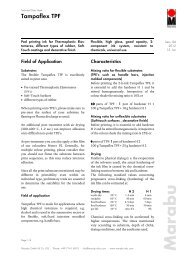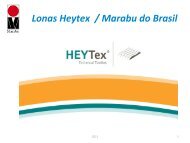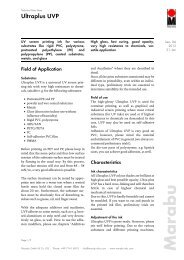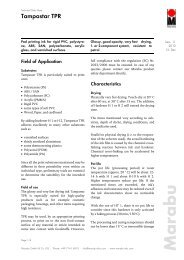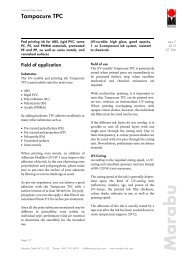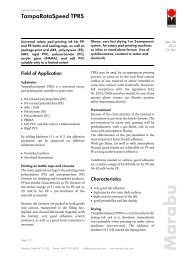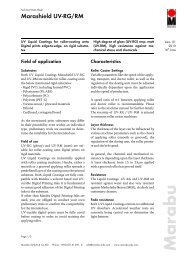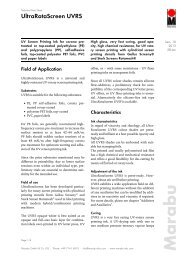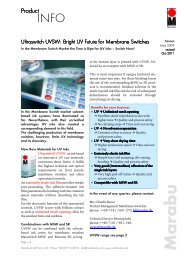Ultrapack UVPK - Marabu Printing Inks
Ultrapack UVPK - Marabu Printing Inks
Ultrapack UVPK - Marabu Printing Inks
You also want an ePaper? Increase the reach of your titles
YUMPU automatically turns print PDFs into web optimized ePapers that Google loves.
Technical Data Sheet<br />
<strong>Ultrapack</strong> <strong>UVPK</strong><br />
UV-screen printing ink for pre-treated<br />
polyethylene and polypropylene, polyester,<br />
PET and PETG, PVC, and PC<br />
High gloss, press-ready, good opacity,<br />
high filler resistance<br />
Vers. 6<br />
2012<br />
01. Aug<br />
Field of Application<br />
Substrates<br />
<strong>Ultrapack</strong> <strong>UVPK</strong> is a universal UV-screen printing<br />
ink suitable for the following substrates:<br />
Field of use<br />
<strong>Ultrapack</strong> <strong>UVPK</strong> is a one-component screen<br />
printing ink curing under UV-light which has<br />
been developed for the particular requirements<br />
and different substrates of container printing.<br />
• Pre-treated polyethylene PE and polypropylene<br />
PP<br />
• Pre-treated and non pre-treated polyester<br />
PET and PETG<br />
• PVC and rigid PVC<br />
• Polycarbonate (PC)<br />
Before printing onto PE and PP please keep in<br />
mind that the non-polar and thus small surface<br />
tension of the substrate surface must be treated<br />
by flaming in the usual way. By this process,<br />
the surface tension will rise and a very good adhesion<br />
from 52 - 58 mN/m is possible. The<br />
surface treatment can be tested by appropriate<br />
test inks or a water test where a wetted bottle<br />
must hold the closed water film for approx. 30<br />
sec.<br />
Furthermore, the substrate surface must be<br />
absolutely free of disturbing residues such as<br />
grease, oil and finger sweat.<br />
Due to the processing parameters, the PET substrate<br />
can show great differences in surface tension<br />
which can be rectified by a pre-treatment<br />
with a ‘soft’ gas flame.<br />
The adhesion of <strong>Ultrapack</strong> <strong>UVPK</strong> on PVC is very<br />
good considering, however, the embrittlement<br />
of PVC by UV-light in the UV-dryer.<br />
Since all the print substrates mentioned may be<br />
different in printability even within an individual<br />
type, preliminary trials are essential to determine<br />
suitability for the intended use.<br />
Page 1/5<br />
For printing onto the non food-contact surface<br />
of any material or article intended to come into<br />
contact with foodstuffs, we recommend using<br />
low migration screen printing ink such as<br />
<strong>Ultrapack</strong> UVFP. However, full compliance<br />
with the regulation (EC) Nr. 2023/2006<br />
must be ensured. In case of any queries please<br />
contact our <strong>Marabu</strong> product safety department<br />
directly.<br />
Characteristics<br />
Ink characteristics<br />
<strong>Ultrapack</strong> <strong>UVPK</strong> colour shades are brilliant at<br />
high gloss and best possible opacity. Further<br />
characteristics:<br />
-press-ready<br />
-fast curing<br />
-flexible ink film, e. g. for tubes<br />
-high filler resistance<br />
-good water resistance<br />
-Opaque White 170/171 for dark substrates<br />
-can be overembossed with hot embossing foil<br />
Adjustment of the ink<br />
<strong>Ultrapack</strong> <strong>UVPK</strong> is press-ready. However,<br />
please stir well before printing.<br />
For a maximum adhesion and resistance to<br />
chemicals and water on different substrates,<br />
there are various adhesion modifiers available,<br />
please see chapter "Additives and Auxiliaries".<br />
<strong>Marabu</strong> GmbH & Co. KG ⋅ Phone: +49 7141 6910 ⋅ info@marabu-inks.com ⋅ www.marabu-inks.com<br />
<strong>Marabu</strong>
Technical Data Sheet<br />
<strong>Ultrapack</strong> <strong>UVPK</strong><br />
Curing<br />
<strong>Ultrapack</strong> <strong>UVPK</strong> is a fast curing UV-ink. A UVcuring<br />
unit with one medium pressure Mercury<br />
Vapour Lamp (power 120-180 W/cm) will<br />
cure <strong>UVPK</strong> at a belt speed of 2000 - 6000<br />
prints/h.<br />
<strong>UVPK</strong> Opaque White 170/171 and <strong>UVPK</strong><br />
Opaque Black 180 cure more slowly due to<br />
their high amount of pigments.<br />
The curing speed of the ink is generally depending<br />
on the kind of UV-curing unit (reflector),<br />
number, age and power of the UV-lamps, the<br />
printed ink film thickness, the colour shade,<br />
the substrate in use, as well as the printing<br />
speed.<br />
<strong>Ultrapack</strong> <strong>UVPK</strong> is a slightly post curing UVink.<br />
The ink film must withstand a crosscut<br />
tape test after having been cooled down to<br />
room temperature. After 24 hours, the printed<br />
ink film will achieve its maximum product and<br />
water, as well as rub resistance.<br />
Fade resistance<br />
Pigments of medium to high fade resistance are<br />
used in the <strong>Ultrapack</strong> <strong>UVPK</strong> ink type. Owing<br />
to this, all <strong>UVPK</strong> shades are generally suited to<br />
an indoor, as well as a limited outdoor use of<br />
up to one year related to the moderate Central<br />
European climate.<br />
Range<br />
Basic Shades - System Ultracolor<br />
922 Light Yellow 952 Ultramarin Blue<br />
924 Med. Yellow 956 Brilliant Blue<br />
926 Orange 960 Blue Green<br />
932 Scarlet Red 962 Grass Green<br />
934 Carmine Red 970 White<br />
936 Magenta 980 Black<br />
950 Violet<br />
Further Color Shades<br />
170 Opaque White<br />
171 Thixotropic Opaque White<br />
180 Opaque Black<br />
Opaque White 171 has a higher thixotropy<br />
thus showing reduced flow properties in the<br />
screen at machine stops.<br />
All shades are intermixable. Mixing with other<br />
ink types should be avoided in order to maintain<br />
the special characteristics of this outstanding<br />
ink range.<br />
All basic shades are included in our <strong>Marabu</strong>-<br />
ColorFormulator (MCF). They build the basis<br />
for the calculation of individual colour matching<br />
formulas, as well as for shades of the common<br />
colour reference systems HKS ® , PAN-<br />
TONE ® , and RAL ® . All formulas are stored<br />
in the <strong>Marabu</strong>-Color Manager software.<br />
Stress resistance<br />
After proper and thorough drying, the ink film<br />
exhibits outstanding adhesion as well as rub,<br />
scratch, and block resistance and is highly resistant<br />
to solvents (see DIN 16 524), alcohol<br />
(ethanol 99.8 %), finger sweat and other usual<br />
alkaline and acid fillers. The resistance to water<br />
storing tests can be increased by adding 2-4 %<br />
of Hardener H 2 as adhesion modifier.<br />
Page 2/5<br />
The pigments used in the above mentioned<br />
standard shades, based on their chemical<br />
structure, correspond to the EEC regulations<br />
EN 71/part 3, safety of toys - migration of<br />
specific elements.<br />
Due to a possible direct contact with the<br />
mouth, however, we do not recommend to use<br />
this ink neither for baby bottles or toys, nor for<br />
food packaging in direct contact with food<br />
since the possible presence of residual<br />
monomers and degradation products of the<br />
photoinitiators cannot be completely excluded<br />
even if sufficiently cured.<br />
<strong>Marabu</strong> GmbH & Co.KG ⋅ Phone: +49 7141 6910 ⋅ info@marabu-inks.com ⋅ www.marabu-inks.com<br />
<strong>Marabu</strong>
Technical Data Sheet<br />
<strong>Ultrapack</strong> <strong>UVPK</strong><br />
When printing onto exterior packaging for<br />
food or similar goods, we recommend carrying<br />
out a migration test with the final product.<br />
Additives<br />
Transparent Base <strong>UVPK</strong> 409<br />
Thixotropic auxiliary for 4-colour process<br />
printing, fine details, and reverse printing. By<br />
adding transparent base, the ink’s density will<br />
be reduced and can be adjusted according to the<br />
print copy.<br />
Special Binder <strong>UVPK</strong> 904<br />
Addition:<br />
1 - 25% parts by weight<br />
Special Binder <strong>UVPK</strong> 904 can be used as<br />
bronze binder or as extender for basic shades.<br />
An addition of <strong>UVPK</strong> 904 will accelerate the<br />
curing speed reducing, however, the opacity as<br />
well as the outdoor resistance at the same time.<br />
Bronzes<br />
Low-priced, slightly structured Bronze<br />
Pastes<br />
6 months pot life, fair opacity<br />
S-UV 191 Silver 4:1- 7:1<br />
S-UV 192 Rich Pale Gold 4:1- 7:1<br />
S-UV 193 Rich Gold 4:1- 7:1<br />
High-gloss fine pigmented Bronzes<br />
24h pot life, excellent opacity<br />
S-UV 296 High-gloss Silver 6:1—9:1<br />
S-UV 297 High-gloss Rich Pale Gold 6:1—9:1<br />
S-UV 298 High-gloss Pale Gold 6:1—9:1<br />
High-gloss, metallic Bronzes<br />
Slightly structured, excellent rub resistance, max.<br />
12h pot life<br />
S-UV 291 High-gloss Silver 4:1 — 10:1<br />
S-UV 293 High-gloss Rich Gold 4:1 — 10:1<br />
The recommended mixing ratio can be varied<br />
according to the required opacity and curing<br />
properties. All figures in brackets are guidelines<br />
for mixtures with <strong>UVPK</strong> 904 Special Binder<br />
while the first figure is standing for the parts by<br />
weight of <strong>UVPK</strong> 904.<br />
Various bronze pastes are available which can<br />
be mixed with <strong>UVPK</strong> 904. They can be chosen<br />
according to the required opacity, cost limit,<br />
visual impression, and curing characteristics.<br />
Due to the bigger pigment size of bronze<br />
powders, we recommend a coarser fabric, e. g.<br />
120-34.<br />
S 181 Aluminium 6:1<br />
S 182 Rich Pale Gold 5:1<br />
S 183 Rich Gold 5:1<br />
S 184 Pale Gold 5:1<br />
S 186 Copper 4:1<br />
S 190 Aluminium, rub-resistant 6:1<br />
Bronze mixtures cannot be put into storage for<br />
later use. Therefore, prepare fresh mixes daily<br />
(to be processed within 8 h).<br />
Page 3/5<br />
Auxiliaries<br />
Accelerator UV-B1<br />
Addition:<br />
<strong>Marabu</strong> GmbH & Co.KG ⋅ Phone: +49 7141 6910 ⋅ info@marabu-inks.com ⋅ www.marabu-inks.com<br />
1 — 2% parts by weight<br />
Accelerates the curing reaction of the ink and<br />
increases the adhesion to the substrate owing<br />
to a better depth curing.<br />
Accelerator UV-B2<br />
Addition:<br />
1 — 4% parts by weight<br />
Accelerates the curing speed, and increases the<br />
surface hardness of the ink further improving<br />
the degree of gloss.<br />
UV-HV 4 Adhesion Modifier<br />
Addition:<br />
0,5 - 4 % parts by weight<br />
White 970, 170, 171: 2 % parts by weight<br />
<strong>Marabu</strong>
Technical Data Sheet<br />
<strong>Ultrapack</strong> <strong>UVPK</strong><br />
UV-HV 4 improves the adhesion on<br />
challenging substrates such as high-gloss PP or<br />
PET or when over-printing overcured colour<br />
shades. The best possible adhesion and scratch<br />
resistance is achieved after 12 - 24 h<br />
(preliminary trials are necessary!).<br />
UV-HV 4 must be stirred well into the ink.<br />
Ink mixtures cannot be put into storage for<br />
later use, please prepare fresh mixes (to be<br />
processed within 2 to 4 h).<br />
Hardener H 2 (as adhesion modifier)<br />
Addition:<br />
2 - 4 % parts by weight<br />
White 970, 170, 171: 2 % parts by weight<br />
By adding H 2, the water resistance and in special<br />
cases, adhesion to the substrate can be improved.<br />
H 2 must be stirred well into the ink.<br />
<strong>UVPK</strong> mixtures with H 2 cannot be stored for<br />
later use. Please prepare fresh mixes to be<br />
processed within 4 to 6 h.<br />
Thickening agent STM<br />
Addition:<br />
0.5 - 2 % parts by weight<br />
Auxiliary to enhance the ink viscosity without<br />
influencing significantly the degree of gloss.<br />
Please stir well! The use of an automatic mixing<br />
machine is recommended.<br />
Levelling agent UV-VM<br />
Addition: 0.5 - 1.5 % parts by weight<br />
Helps to eliminate flow problems (e. g.<br />
bubbles, etc.) which may arise due to residuals<br />
on the substrate’s surface, insufficient screen<br />
tension or incorrect adjustment of the<br />
machines.<br />
A higher proportioning may reduce the ink’s<br />
adhesion when overprinting. UV-VM is to be<br />
stirred well und homogeneously before<br />
printing.<br />
Cleaner<br />
For manual cleaning of screen printing stencils<br />
and tools our cleaner UR 3 (flash point 42° C)<br />
or UR 4 (flash point 52°C) can be used.<br />
We generally recommend to clean the tools<br />
immediately after printing, especially if crosslinked<br />
adhesion modifiers have been used.<br />
Fabrics and stencils<br />
Selection of fabric depends on the printing<br />
conditions, the desired curing speed and<br />
mileage as well as the required opacity.<br />
Generally, fabrics of 120-31 to 180-31 can be<br />
used.<br />
Thinner UVV3<br />
Addition:<br />
Page 4/5<br />
1 - 10 % parts by weight<br />
Thinner for reducing the printing viscosity to<br />
be used on high-speed printing machines and<br />
for processing printing bronzes. The reactivity<br />
of the printed ink film is slightly increased.<br />
We do not recommend to add a higher<br />
quantity of thinner since this will cause a<br />
reduction of the surface’s hardness. UVV3 is<br />
part of the cross-linked matrix when UVcured.<br />
For UV inks, all commercially available<br />
capillary films (15-20 µm) or solvent resistant<br />
photo emulsions and combined stencils can be<br />
used.<br />
Control and reduction of the printed ink film<br />
are fundamental for 4-colour process printing<br />
with UV-curable inks. We recommend a mesh<br />
count between 150-27 to 180-27. A uniform<br />
screen tension (14-18 N) of all fabrics used is<br />
further important.<br />
<strong>Marabu</strong> GmbH & Co.KG ⋅ Phone: +49 7141 6910 ⋅ info@marabu-inks.com ⋅ www.marabu-inks.com<br />
<strong>Marabu</strong>
Technical Data Sheet<br />
<strong>Ultrapack</strong> <strong>UVPK</strong><br />
Mileage<br />
Mileage is about 60-80 m 2 /kg of printed<br />
surface according to mesh and substrate<br />
chosen.<br />
Shelf life<br />
Shelf life depends very much on the formula/<br />
reactivity of the ink system as well as the storage<br />
temperature. It is 2 years for an unopened<br />
ink if stored in a dark room at a temperature of<br />
15 to 25 C. Under different conditions, particularly<br />
higher storage temperatures, the shelf<br />
life is reduced. In such cases, <strong>Marabu</strong>’s warranty<br />
expires.<br />
Labelling<br />
For our ink type <strong>Ultrapack</strong> <strong>UVPK</strong> and its additives<br />
and auxiliaries there are current Material<br />
Safety Data Sheets available according to ECregulation<br />
1907/2006, covering in detail all<br />
relevant safety data including the labelling<br />
according to the present EC regulations as to<br />
health and safety labelling requirements.<br />
Such health and safety data may also be obtained<br />
from the respective label.<br />
Note<br />
Our technical advice whether spoken, written,<br />
or through test trials corresponds to our current<br />
knowledge to inform about our products<br />
and their use. This is not meant as an assurance<br />
for certain properties of the products nor their<br />
suitability for each application.<br />
You are, therefore, obliged to conduct your<br />
own tests with our supplied products to confirm<br />
their suitability for the desired process or<br />
purpose. The selection and testing of the ink<br />
for specific application is exclusively your responsibility.<br />
Should, however, any liability claims arise,<br />
such claims shall be limited to the value of the<br />
goods delivered by us and utilised by you with<br />
respect to any and all damages not caused intentionally<br />
or by gross negligence.<br />
Safety Regulations for UV<br />
Screen <strong>Printing</strong> <strong>Inks</strong><br />
We recommend that UV screen printing inks<br />
and auxiliaries should be handled with particular<br />
care. Follow the instructions given on the<br />
labels and in the Material Safety Data Sheets.<br />
Page 5/5<br />
<strong>Marabu</strong> GmbH & Co.KG ⋅ Phone: +49 7141 6910 ⋅ info@marabu-inks.com ⋅ www.marabu-inks.com<br />
<strong>Marabu</strong>



